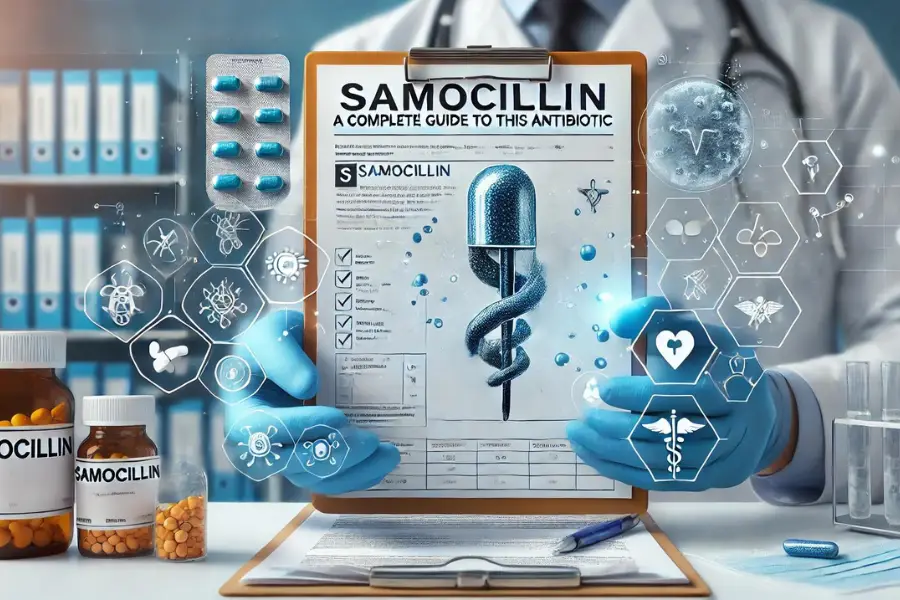Samocillin, though not as widely known as some other antibiotics, is an important medication in the realm of bacterial infection treatment. This guide will provide a comprehensive overview of Samocillin, its uses, benefits, side effects, and considerations for use.
What is Samocillin?

Samocillin is a semi-synthetic penicillin antibiotic. It belongs to the beta-lactam family of antibiotics, which are characterized by their ability to inhibit bacterial cell wall synthesis. This results in the death of the bacteria, thereby helping to clear the infection. As with other antibiotics in this class, Samocillin is effective against a broad range of gram-positive and some gram-negative bacteria.
How Does Samocillin Work?

Samocillin works by targeting the bacterial cell wall. The cell wall is crucial for the survival of bacteria as it provides structural integrity. Samocillin binds to specific proteins within the bacterial cell wall, known as penicillin-binding proteins (PBPs). By inhibiting these proteins, Samocillin disrupts the construction of the bacterial cell wall, leading to the weakening and eventual rupture of the cell, which results in the bacteria’s death.
Indications for Use

Samocillin is prescribed for a variety of bacterial infections. Some of the common conditions treated with Samocillin include:
- Respiratory Tract Infections: This includes conditions like bronchitis, pneumonia, and sinusitis caused by susceptible bacteria.
- Urinary Tract Infections (UTIs): Samocillin can effectively treat UTIs caused by certain bacterial strains.
- Skin and Soft Tissue Infections: This includes cellulitis, abscesses, and infected wounds.
- Ear Infections: Otitis media, a common ear infection, can be treated with Samocillin.
- Gastrointestinal Infections: Some bacterial infections of the gastrointestinal tract may respond well to this antibiotic.
Dosage and Administration

The dosage of Samocillin depends on the type and severity of the infection, as well as the patient’s age, weight, and overall health condition. Typically, Samocillin is administered orally in the form of capsules or liquid suspension. In more severe cases, it may be given intravenously in a hospital setting.
General Dosage Guidelines:
- Adults: The typical dosage ranges from 250 mg to 500 mg every 6-8 hours, depending on the infection.
- Children: The dosage is usually determined based on the child’s weight and the severity of the infection, often ranging from 20 to 50 mg/kg/day in divided doses.
It is essential to complete the full course of Samocillin as prescribed by a healthcare provider, even if symptoms improve before the medication is finished. Stopping the antibiotic prematurely can lead to the development of antibiotic-resistant bacteria.
Side Effects of Samocillin

Like all medications, Samocillin can cause side effects. Most side effects are mild and transient, but some can be more serious.
Common Side Effects:
- Nausea
- Diarrhea
- Rash
- Vomiting
- Abdominal pain
Serious Side Effects:
- Severe allergic reactions (anaphylaxis), which can manifest as difficulty breathing, swelling of the face or throat, and hives.
- Clostridium difficile-associated diarrhea, a more severe form of diarrhea caused by a bacterial imbalance in the gut.
- Stevens-Johnson syndrome, a rare but serious disorder that affects the skin and mucous membranes.
Patients should seek immediate medical attention if they experience any signs of a severe allergic reaction or other serious side effects.
Precautions and Interactions

Before starting Samocillin, it’s important to inform your healthcare provider of any allergies, especially to penicillin or cephalosporin antibiotics. Patients with a history of kidney disease, liver disease, or gastrointestinal issues should use Samocillin with caution.
Samocillin can interact with other medications, potentially altering their effectiveness or increasing the risk of adverse effects. Notable interactions include:
- Oral Contraceptives: Samocillin may reduce the effectiveness of birth control pills, so alternative or additional contraceptive methods may be advised.
- Anticoagulants: Samocillin can affect the efficacy of blood thinners, such as warfarin, leading to an increased risk of bleeding.
- Methotrexate: Concurrent use with Samocillin may increase the toxicity of methotrexate.
Conclusion
Samocillin is a versatile and effective antibiotic used to treat a variety of bacterial infections. While it is generally well-tolerated, it’s crucial to use it as directed by a healthcare professional to avoid complications or the development of antibiotic resistance. As with any medication, being informed about its uses, side effects, and potential interactions can help ensure safe and effective treatment.
If you suspect you have a bacterial infection that may require treatment with Samocillin, consult your healthcare provider for a thorough evaluation and appropriate prescription.
FAQs
Q1: What is Samocillin?
Samocillin is a semi-synthetic penicillin antibiotic used to treat a wide range of bacterial infections by inhibiting bacterial cell wall synthesis.
Q2: What infections does Samocillin treat?
Samocillin is commonly used to treat respiratory tract infections, urinary tract infections, skin and soft tissue infections, ear infections, and some gastrointestinal infections.
Q3: What are the side effects of Samocillin?
Common side effects include nausea, diarrhea, rash, vomiting, and abdominal pain. Serious side effects may include severe allergic reactions, Clostridium difficile-associated diarrhea, and Stevens-Johnson syndrome.
Q4: How should Samocillin be taken?
Samocillin should be taken exactly as prescribed by a healthcare provider, typically every 6-8 hours for the duration of the treatment course. It can be taken orally in the form of capsules or liquid suspension.
Q5: Can Samocillin interact with other medications?
Yes, Samocillin can interact with oral contraceptives, anticoagulants, and methotrexate, among others. Always inform your healthcare provider about all medications you are taking.
For more insights, visit Jessica Ditzel.




